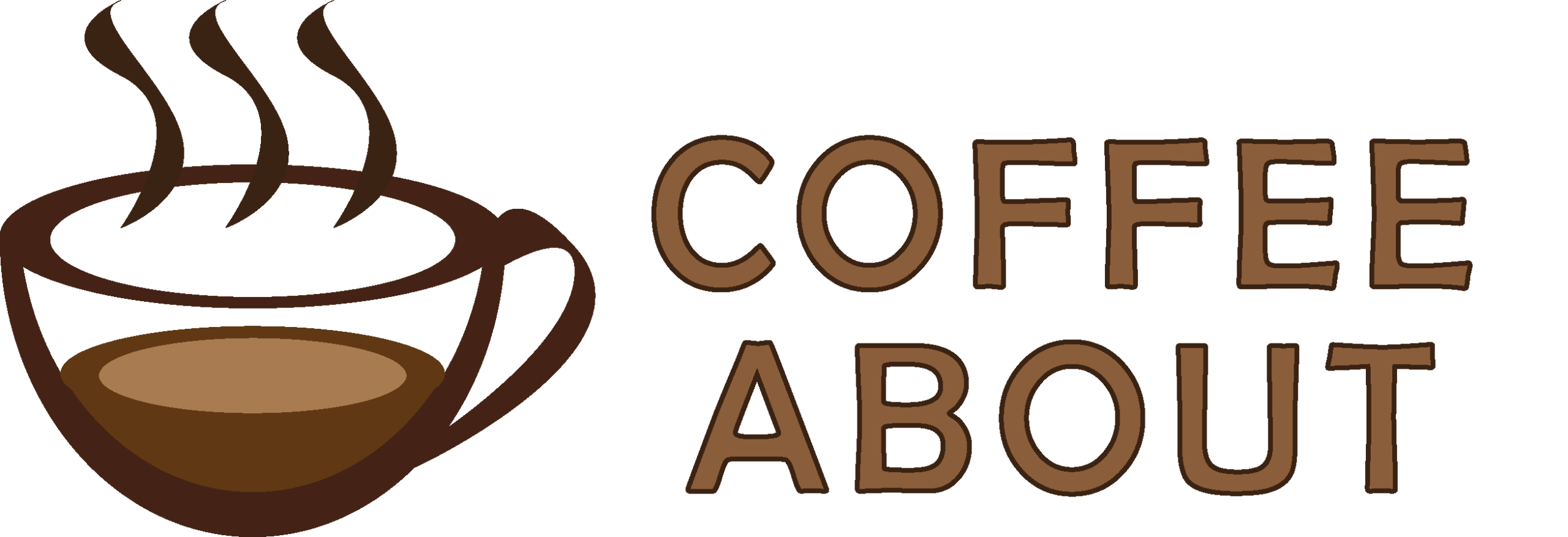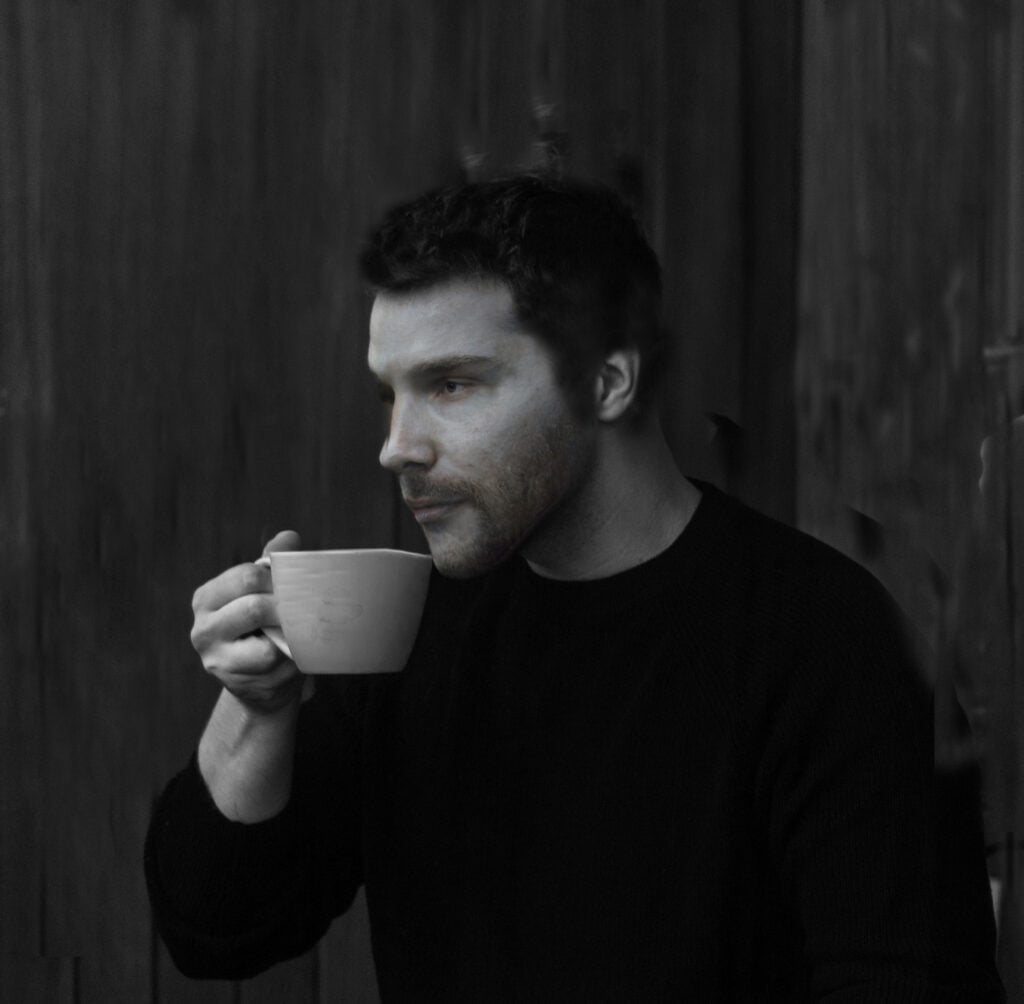Both Flat white and Latte are Milky Espresso based Drinks. The main difference is latte has a higher proportion of milk and is typically served with flavored syrups, resulting in a creamier and sweeter taste. While a flat white is a small drink with less proportion of milk and has a coffee-forward taste.
Both Flat white and Latte are strikingly similar drinks with regional variations, and when deciding between the two, you can ask your barista as he might have some intriguing perspectives to share.
Many Baristas call Flat white a smaller Latte!
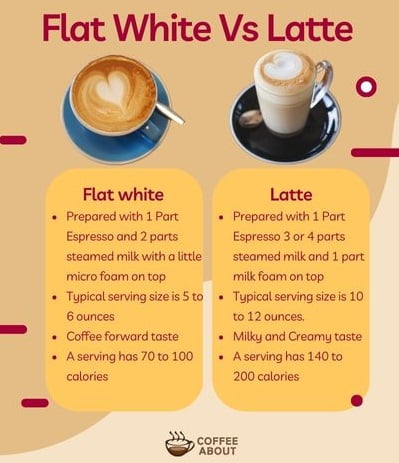
What is Flat White?
A flat white is a coffee beverage made with a double shot of espresso and steamed milk, which is poured over the espresso to create a smooth, velvety texture. It originated in Australia and New Zealand in the 1980s and has since become popular around the World.
Flat white has a stronger coffee taste compared to a latte as the ratio of milk in Flat white is typically lower.
A typical size of Flat white coffee is around 200 mL and it is served in a small ceramic cup.
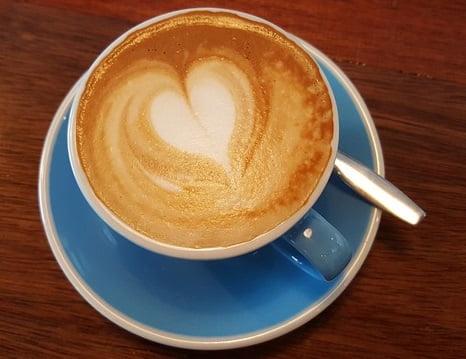
What is Latte?
Latte is a popular coffee drink that originated in Italy. It is made by mixing espresso with steamed milk and topped with a thin layer of frothed milk.
The ratio of milk to espresso in a latte is usually 3:1 or 4:1. The milk in a latte is steamed until it’s frothy and airy, which gives the drink a sweeter, creamier taste than a flat white.
Latte is often flavored with syrups or spices like vanilla, caramel, or cinnamon and served in tall glasses or larger ceramic cups.
Latte became popular in the United States during the 1980s, thanks to the rise of specialty coffee shops such as Starbucks, Dunkin, McCafe, etc.
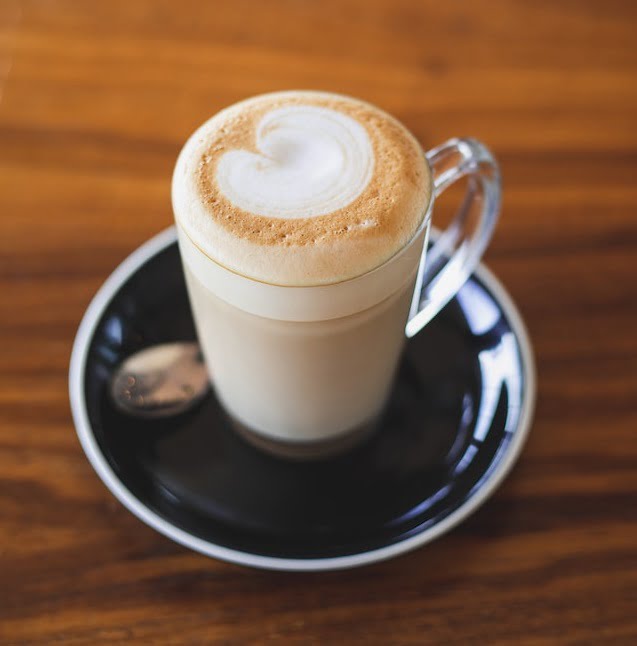
The amount and type of milk in Latte and Flat White
Flat white is made with a double shot of espresso and less milk than a latte, usually about 4 ounces. The milk in a flat white is steamed until it’s silky and smooth, with a thin layer of microfoam on top.
Latte, on the other hand, is made either with a single shot or double shot espresso and more milk than a flat white, usually about 6-10 ounces. The milk in a latte is steamed until it’s frothy and airy, with a layer of thick foam on top.
Whole milk is the most commonly used in flat white and latte, but some coffee shops offer non-dairy alternatives such as soy, almond, or oat milk.
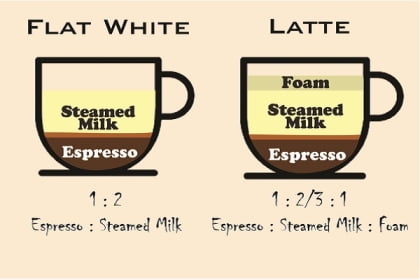
Method of Preparation
Latte can be easily prepared at home with or without any milk frother but for flat whites, you typically need a steaming wand and pitcher.
The special thing about Flat white is a white colored flat layer of microform on top thus the name flat white.
In order to make a microform, you need a steaming wand since it creates a velvety milk texture with a thin foam layer. A milk frother, on the other hand, creates large aerated bubbles of milk, which are ideal for lattes but not for flat whites.
The term “microfoam” describes a quality of frothed milk in which the bubbles are so small and so numerous that they can’t be seen, but they can be felt on the palate
Seriouseats
The taste and flavors of flat white vs Latte
Latte, with its higher milk-to-espresso ratio, generally has a milder coffee flavor and a sweeter taste compared to a flat white. The frothy texture of the milk in a latte coats the taste buds, giving a more rounded flavor profile.
The flat white has a richer and creamier taste because of the silky texture of the steamed milk. The higher espresso-to-milk ratio in flat white results in a stronger coffee flavor that is more prominent in every sip.
The type of milk used can also affect the taste of both drinks. For example, using whole milk in a latte can give it a creamier taste, while using almond milk in a flat white can result in a nuttier flavor profile.
Latte is generally flavored with syrups or spices, and a flat white is usually served plain to allow the coffee and milk flavors to shine. However, adding a sprinkle of cocoa powder or a drizzle of caramel syrup can add an extra layer of flavor to a flat white without overpowering the coffee taste.
Personally, I prefer Flat white over a Latte because of its rich Espresso-forward taste.
“With a latte and cappuccino, the milk is steamed and poured on the espresso shots and topped with a layer of foam (the amount of foam differs based on the beverage). With a flat white, the milk is aerated to create thin layer of foam—microfoam—which is carefully poured over and combined throughout the beverage to allow the espresso to rise to the top.”
Sprudge
The calories and caffeine content
As both Latte and Flat white are prepared with double-shot Espresso the amount of caffeine is almost the same which is around 120-130 mg.
A typical 12 oz serving of Latte has around 141 calories while a 6 oz serving of flat white has around 83 calories
If you’re trying to watch your calorie intake, opting for non-dairy milk or a smaller size can help cut down on extra calories.
Latte and Flat White at Starbucks
Starbucks, the American coffee giant, is credited with popularizing lattes and their various flavors around the world.
At Starbucks the Latte is like a blank canvas, waiting to be painted with flavors like vanilla, caramel, pistachio, or even that beloved pumpkin spice. Plus, you can enjoy it hot or cold, and it’s typically served in larger sizes, ranging from 10 to 16 ounces.
Meanwhile, Starbucks flat whites are a scaled-down drink using ristretto espresso shots for a sweeter, more intense coffee taste. They have less milk than a latte and feature a thin layer of microfoam rather than thick froth.

Flat White vs Latte, So What’s Better?
The taste of a flat white and a simple latte is largely dependent on the recipe used by the café, as there is very little difference between the two drinks.
As a coffee lover myself, I enjoy all espresso-based drinks, but I do have a slight preference for flat whites. I love the strong espresso flavor and smooth texture that comes with the perfect ratio of milk to espresso. It’s the perfect pick-me-up for a busy morning or a mid-afternoon slump.
However, when I’m in the mood for something sweeter and creamier, I reach for flavored Vanilla or Pumpkin latte drinks. It’s a great choice for a relaxing weekend brunch or a cozy evening treat.
So why not try both and see which one you like best?
Discover other interesting comparisons
